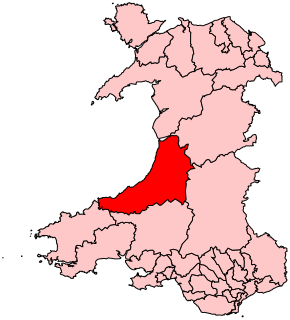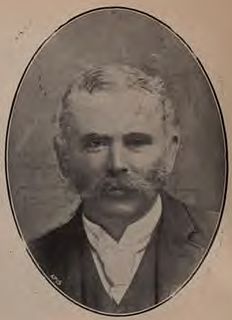Related Research Articles

Ceredigion, formerly Cardiganshire, is a constituency represented in the House of Commons of the UK Parliament. Created in 1536, the franchise expanded in the late 19th century and on the enfranchisement of women and its boundaries remained virtually unchanged until 1983. From 1536 until 1885 the area had two seats : a county constituency (Cardiganshire) comprising the rural areas, the other the borough constituency known as the Cardigan District of Boroughs comprising a few separate towns; in 1885 the latter was abolished, its towns and electors incorporated into the former, reduced to one MP. The towns which comprised the Boroughs varied slightly over this long period, but primarily consisted of Cardigan, Aberystwyth, Lampeter and Adpar, the latter now a suburb of Newcastle Emlyn across the Teifi, in Carmarthenshire.

Abel Thomas was a Welsh Liberal politician and lawyer.

Walter Rice Howell Powell was a Welsh landowner and Liberal politician. He was Member of Parliament for Carmarthenshire from 1880 until 1885 and for West Carmarthenshire from 1885 until his death in 1890.
Henry George Allen MA JP QC was a British lawyer and Liberal politician.
The Carmathen Boroughs by-election of 1876 was fought on 14 August 1876. The byelection was fought due to the resignation of the incumbent Conservative MP, Charles William Nevill. It was won by the Liberal candidate Arthur Cowell-Stepney, who was returned unopposed.
The third election to the Cardiganshire County Council took place in March 1895. It was preceded by the 1892 election and followed by the 1898 election
Elections to Pembrokeshire County Council were held on 1 May 2008. It was preceded by the 2004 election and followed by the 2012 election. On the same day there were elections to the other 21 local authorities in Wales, and to community council elections in Wales. There were also elections elsewhere in the United Kingdom
The second election to the Glamorgan County Council was held on 8 March 1892. The 1889 election was the first contest and the next was the 1895 election. Glamorgan County Council had been established by the 1888 Local Government Act, and the first election held in January 1889. Glamorgan was by far the largest county in Wales in terms of population. The county of Glamorgan was at this time becoming heavily industrialised, although some areas such as the Vale of Glamorgan remained essentially rural. The rise of nonconformist liberalism, especially since the 1860s, throughout Wales, had challenged the prevailing influence of the landed gentry. However, even in 1889, the traditional forces remained influential and no working men were elected to the Council. This changed in 1892 with the unopposed return of David Morgan in Aberdare and the success of Isaac Evans in Resolven.
The first election to Pembrokeshire County Council was held in January 1889. It was followed by the 1892 election. The county was divided into numerous single member wards with two or more councillors elected to represent Tenby and Pembroke Dock.
The third election to Glamorgan County Council election was held on 4 March 1895. It was preceded by the 1892 election and followed by the 1898 election.
The Glamorgan County Council election, 1898 was the fourth contest for seats on this authority. It was preceded by the 1895 election and followed by the 1901 election. Glamorgan was by far the largest county in Wales in terms of population. Glamorgan County Council had been established by the 1888 Local Government Act, and the first elections held in early 1889. The county of Glamorgan was at this time becoming heavily industrialised, although some areas such as the Vale of Glamorgan remained essentially rural. The rise of nonconformist liberalism, especially since the 1860s, throughout Wales, had challenged the prevailing influence of the landed gentry. However, even in 1889, the traditional forces remained influential and no working men were elected to the Council. This changed in 1892 with the unopposed return of David Morgan in Aberdare and the success of Isaac Evans in Resolven.
The Glamorgan County Council election, 1901 was the fifth contest for seats on this authority. It was preceded by the 1898 election and followed by the 1904 election. Glamorgan was by far the largest county in Wales in terms of population. Glamorgan County Council had been established by the 1888 Local Government Act, and the first elections held in early 1889. The county of Glamorgan was at this time becoming heavily industrialised, although some areas such as the Vale of Glamorgan remained essentially rural. The rise of nonconformist liberalism, especially since the 1860s, throughout Wales, had challenged the prevailing influence of the landed gentry. However, even in 1889, the traditional forces remained influential and no working men were elected to the Council. This changed in 1892 with the unopposed return of David Morgan in Aberdare and the success of Isaac Evans in Resolven.
The Glamorgan County Council election, 1904 was the sixth contest for seats on this authority. It was preceded by the 1901 election and followed by the 1907 election. Glamorgan was by far the largest county in Wales in terms of population. Glamorgan County Council had been established by the 1888 Local Government Act, and the first elections held in early 1889. The county of Glamorgan was at this time becoming heavily industrialised, although some areas such as the Vale of Glamorgan remained essentially rural. The rise of nonconformist liberalism, especially since the 1860s, throughout Wales, had challenged the prevailing influence of the landed gentry. However, even in 1889, the traditional forces remained influential and no working men were elected to the Council.
The fifth elections for Cardiganshire County Council took place in March 1901. They were preceded by the 1898 election and followed by the 1904 election
The Glamorgan County Council election, 1907 was the seventh contest for seats on this local authority in Wales. It was preceded by the 1904 election and followed by the 1910 election.
The second election to the Carmarthenshire County Council was held in March 1892. It was preceded by the 1889 election and followed by the 1895 election.
The third election to the Carmarthenshire County Council was held in March 1895. It was preceded by the 1892 election and followed by the 1898 election.
The fifth election to the Carmarthenshire County Council was held in March 1901. It was preceded by the 1898 election and followed by the 1904 election.
The fourth election to Pembrokeshire County Council was held in March 1898. It was preceded by the 1895 election and followed by the 1901 election.
The fifth election to Pembrokeshire County Council was held in March 1901. It was preceded by the 1898 election and followed by the 1904 election.
References
- 1 2 "County Council Elections. Pembrokeshire". Welshman. 8 March 1895. p. 5. Retrieved 4 September 2017.
- ↑ "County Councils. Pembrokeshire". Welshman. 15 March 1895. p. 8. Retrieved 5 September 2017.